Policy
This policy establishes the emergency notification program at Binghamton University,
commonly referred to as the "B-ALERT" emergency notification system. This document,
in aggregate, constitutes the University's Emergency Notification Plan.
Multiple regulations address elements of higher education emergency notification systems.
This policy incorporates the following regulations/standards into the Emergency Notification
Plan:
- The Higher Education Opportunity Act
- The Jeanne Clery Disclosure of Campus Security Policy and Campus Crime Statistics Act (The Clery Act)
- Department of Homeland Security National Preparedness Goal (NPG)
- Emergency Management Accreditation Program – Emergency Management Standard
- National Fire Protection Association (NFPA) 1600
Purpose
The purpose of this policy is to define use of Binghamton University's Emergency Notification System. This system has multiple alert components that are intended to improve emergency communications between the University's administration and Binghamton University students, staff, faculty and visitors. The primary objective of the emergency notification system is to provide timely notification and warning of threats, imminent or occurring, that pose an immediate threat to the health, safety or general welfare of students, staff, faculty and/or visitors while on campus. This document establishes the protocols that are to be taken in case of an emergency in order to promote the safety of everyone on campus. The Emergency Notification System includes:
- Text/Email messaging
- Outdoor siren
- Electronic LED message boards
- Alertus emergency notification smartphone application (mobile app)
- Alertus computer desktop pop-up notifications (coming Summer 2019)
- Campus VoIP phone announcements (coming Summer 2019)
- BU Alert line 607-777-7700
- University web page
- Social media sites (i.e. Twitter, Facebook, etc.)
- University email listservs (i.e. B-Line and Dateline)
- Local television and radio
- Mobile public address systems (vehicle mounted)
- Courier/messenger (manually delivered)
Assumptions
In order to plan for and consider the effectiveness of the Binghamton University emergency notification system, one must take into account several planning assumptions:
- With the exception of some forecasted weather situations, most emergencies requiring activation of the emergency notification system will be "no notice." This means that there is no advance warning of a situation that may pose an immediate threat to life safety.
- With the above assumption in mind, there is a need to streamline the emergency alert activation process to ensure timely notification and warning. A delay in providing emergency related information can expose the campus community to dangerous situations.
- No single method of communication will reach everyone, everywhere, every time. Utilization of numerous and varied communication methods is required.
- Electronic communication mechanisms are subject to failure. Redundancy through utilization of numerous and various communication methods is required.
- Even with numerous and various communication methods, delivery of 100% of the messages cannot be guaranteed.
- Studies have shown that the average person requires three sources of input to fully realize that an emergency is occurring. Inputs may include direct observation of the emergency (explosions, breaking glass, screeching, smoke, chemical or burning smell) or notifications (sirens, a text message, etc.). This emphasizes the need to employ multiple delivery methods to reinforce the message.
- Due to limitations beyond the University's control, portions of the intended audience will receive the emergency messages in a later timeframe than desired.
- Some of the emergency communication methods identified herein are "passive" systems, requiring deliberate action on the part of the recipient to obtain the emergency message. Many will not take this required action.
- Due to the limitations of passive systems, a number of the communication methods must be "active" systems, requiring minimal efforts on the recipient's part to receive and comprehend the message.
- Despite best efforts, errant information may still be generated and distributed by alternate means of communication (i.e. word of mouth, social media, etc.). This requires messages to be clear, concise, succinct, and accurate.
- Notification systems must account for communication impairments (hearing or sight).
- Language barriers, such as with international students, will result in misunderstood receipt of messages.
- Emergency messages must be identifiable as "official" Binghamton University messages.
- An educational campaign is required to introduce the system to every person on campus. This educational campaign must be ongoing to inform each new person that comes on campus through student or new employee orientation.
- Regular testing of the system is required to ensure functionality and to familiarize recipients with the system's features. All tests must be evaluated and corrective action recommendations developed, as necessary.
- As communication technology evolves, new communication methods may be identified as others become obsolete. A constant evaluation of effectiveness is required.
Responsibilities
Office of Emergency Management (OEM)
Shall provide oversight, management and coordination of the University's emergency notification system. The Office of Emergency Management shall ensure compliance with all applicable federal, state and local laws pertaining to emergency notification and warning requirements. OEM may initiate a B-ALERT for any immediate or imminent threat to the campus community.
NYS University Police (NYSUP)
The NYS University Police shall participate in the emergency notification and warning system. NYSUP may initiate any B-ALERT for any immediate or imminent threat to the campus community.
Communications and Marketing
Shall participate in the emergency notification and warning system. Communications and Marketing may disseminate a B-ALERT emergency message via delivery methods under its operational control.
Alert Methodology
Alert methods are classified as primary versus secondary and active versus passive.
Primary vs. Secondary
Primary alert methods include those that can be promptly initiated, have minimal time to deliver and reach a broad audience.
Secondary alert methods include those that may be time-consuming to activate and/or have a limited audience.
Active vs. Passive
Active alert methods include those that require minimal effort on the part of the recipient to receive the alert message.
Passive alert methods include those that require a concerted action on the part of the recipient to seek and receive the message.
|
PRIMARY |
SECONDARY |
|
|
ACTIVE |
|
|
|
PASSIVE |
|
|
Alert Levels
Depending on the nature, severity and duration of an incident or threat, one of the following Alert Levels is selected:
Full Activation
A situation that requires the immediate activation of all or most of the primary and secondary delivery methods.
Partial Activation
A situation that requires use of only certain, selected primary delivery methods.
Information Only
A situation that is not a warning of an immediate threat, but rather a dissemination of information that mitigates concern or potential for rumors.
Public Service Announcement
The distribution of information that serves to promote safety and a culture of preparedness by raising awareness.
Urgency Levels
Immediate
Occurring now or likely to occur at any moment; impending. Requires immediate action.
Urgent
Not immediately life threating but requires information to be disseminated promptly. Distribution of information may only be slightly delayed while all information and facts are gathered.
Minimal
No immediate danger to health or safety. Distribution of information may be delayed while all information and facts are gathered.
Acceptable Use of the Emergency Notification System
The Binghamton University Emergency Notification System shall only be initiated within the acceptable use criteria listed below.
Warnings and instructions related to emergency conditions:
Bomb Threat: There is intelligence to indicate the threat is credible (e.g. potential device has been located).
Civil Disturbance: A demonstration by a large group that is disrupting normal activities and/or showing signs of aggressive behavior.
Fire: Any fire that is potentially placing lives in danger.
Hazardous Material Release: A dangerous material (i.e. chemical, biological, or radiological) that is spreading from a contained area and/or causing lives to be placed in danger.
Major Road Closing: An unanticipated closure that could disrupt safe passage to and from campus.
Medical Emergency: Confirmed contagious disease constituting a campus-wide threat (i.e. pandemic)
Missing Person: If activation of the system has the potential to assist in locating the missing person. Alert for this type of incident shall be limited to the communication devices most appropriate for disseminating information. The outdoor siren should not be used for missing persons.
Physical Assault: Weapons used, significant violence, perpetrator(s) at large (e.g. active shooter; hostage situation).
Time-Sensitive Safety Information: Any time-sensitive safety information (e.g. Campus closure, active criminal activity, etc.) that could potentially allow the recipients avoid harm.
Severe Weather: Any severe weather that has the potential to cause injury to lives or property (i.e. flooding, thunderstorm, wind, tornado, snow/ice/cold, etc.).
Suspicious Package: A package that is believed to have the potential to cause injury to a wide spectrum of lives or property.
Utility Failure: A major disruption of utilities and or possible damage (i.e. gas, electrical, water, etc.).
Other, Life-Threatening: Any other condition where lives are in immediate danger and the Emergency Alert System has the potential to reduce the potential of harm.
All Clear: All-clear and/or additional follow-up messages pertaining to end-of-event. For example: When an alert has been issued due to a potentially severe storm in the area, an "All Clear" message could be sent when the danger has passed.
General notifications of a non-emergency nature shall NOT be permitted via the Emergency Alert System. The use of the system shall be limited to emergency events only.
Pre-Approved Alerts
The following emergency scenarios and associated B-ALERT messages are pre-approved by University officials and eligible for immediate full activation of B-ALERT.
- All Clear
- Chemical Release – Evacuate
- Chemical Release – Shelter in Place
- Civil Disturbance
- Fire
- Gas Leak
- GENERIC – Emergency, Not Defined
- GENERIC – Shots Fired
- GENERIC – Violent Incident
- Lightning – Move indoors now
- Lightning – All Clear
- Tornado Warning
- Tornado Warning - Canceled
Other Alerts
The following scenarios and associated B-ALERT messages are pre-approved by University officials and eligible for immediate partial activation of B-ALERT.
- Boil Water Advisory
- Campus-wide Power Outage
- Crime Bulletin
- Medical Emergency
- Missing Person
See Appendix B for details regarding each scenario and the associated message.
Step-by-Step Procedures and Passcodes
Activation procedures for the B-ALERT emergency notification system are maintained in a separate, secure document. Given the sensitive operational nature of the contents of the system, all procedures and passcodes are considered to be CONFIDENTIAL and are not available for public distribution.
Activation of the Emergency Alert System
In order to activate the Emergency Notification System, the following procedures shall take place:
- When a potentially dangerous situation is identified by any member of the campus community, University Police must be immediately notified by calling 911 (from a campus phone) or 607-777-2222.
- Any NYSUP dispatcher, NYSUP lieutenant, investigator, technical sergeant, chief officer
or member of OEM staff is authorized to activate the system when he/she reasonably
believes a potentially dangerous situation is occurring. This may be a result of multiple
911 phone calls that appear to confirm the situation or a field report from a trusted
first responder.
- For situations where existing policies or past practices do not provide clear direction, the dispatcher may press the Alertus "On-Call Admin" button. When pressed, several administrators will be immediately notified and directed to contact the NYSUP dispatch center to provide immediate consultation.
- Situational awareness may be gathered from a variety of sources to gather information to help make the decision to activate the system. Likely sources of information include, but are not limited to, NYS University Police, the Office of Emergency Management (OEM), senior administrators, Facilities Management, Environmental Health and Safety, Broome County Office of Emergency Services (OES), etc.
- As practical, without jeopardizing life safety, the following individuals or entities may be consulted prior to emergency message
dissemination.
- President's Office
- Vice President for Operations
- Member of the Senior Officer's Group
- Associate Vice President for Emergency Services
- Executive Director, Office of Emergency Management
- Chief of Police
- Senior Director of Communications and Marketing
- Police Supervisor on duty
Decision Criteria
Five criteria shall be considered to determine the type of communication and who activates the warning:
Hazard Type
- What is the hazard? (fire, hazardous spill, shooter, bomb threat)
- What is the impact to Binghamton University? (minor, major, catastrophic)
- What is the potential for the situation to worsen?
- Is the situation under control?
Life Safety / Property Protection
- What is the potential for death?
- What is the potential for serious injury?
- What is the potential for minor injury?
- What is the potential for damage?
- What is the potential for disruption to normal course of business?
Urgency
- How soon does the message need to go out? (seconds, hours, days)
- Is there time for approval?
Audience
- Who needs to be alerted? (administration, faculty, staff, students, guests, parents, media)
- How many people need to be alerted? (dozens, hundreds, thousands)
- Capabilities/limitations
- What are the limitations of the system/tool? (limited audience, lengthy delivery time, mass panic)
- Which system should be used? (press conference, bulk text message, siren)
- How quickly can the messages be sent? (immediately, minutes, hours)
Alert Levels
The tools used to communicate with the campus community during an emergency will vary as a function of:
- Urgency (i.e. minutes, hours, days)
- Time of occurrence (regular business hours, off-hours, semester break)
- Availability of communications tools at the time of the activation
The categories of emergency public information can be summarized according to the framework shown in Appendix A.
The Emergency Alert System shall be flexible in its design and application. To communicate appropriate messages to the University community, the system shall be designed as a 'layered' or 'tiered' system.
Public Service Announcements
These messages are designed to be educational in nature and are not related to an active incident or threat. Examples of this type of message include preparedness steps for Fire Prevention Week, Flood Awareness Week, learning about campus safety programs, etc. Appropriate means for communicating these types of messages include the following methods:
- Emergency Management, NYSUP and/or University website
- Emergency Management, NYSUP and/or University social media sites (i.e. Facebook, Twitter, etc.)
Partial Alert - Information Only
When there is a need to share information that has the potential to impact lives or property, but there is no imminent threat, an informational message may be distributed. Examples of this type of message include National Weather Service weather statements (i.e. outlooks, watches), crime bulletins, etc. Appropriate means for communicating these types of messages include the following methods:
- B-ALERT email
- Email Distribution Lists (i.e. Athletics, Campus Recreation, Grounds, Facilities Management, etc.)
- Emergency Management and/or University website
- Emergency Management and/or University social media sites (i.e. Facebook, Twitter, etc.)
Full Alert
Incidents that pose an immediate threat to life safety shall be distributed as a Full Alert. Examples of this type of message include violent person(s), fire, severe weather warning, etc. Appropriate means for communicating these types of messages include activation of some or all of the following methods:
- B-ALERT – Text, Email, RSS feeds, Social media sites
- Outdoor Siren (as directed by law enforcement officials for criminal acts)
- Alertus Smartphone Application
- Alertus Computer Desktop Notification
- Emergency Management and University website
- Emergency Management and University social media sites (i.e. Facebook, Twitter, etc.)
- BU Alert Line (607-777-7700)
- Electronic LED message boards
- Campus Voicemail
- University email listservs (i.e. B-Line and Dateline)
- Local television and radio
- Mobile public address systems
Activation of Multiple System Elements
When practical and reasonable, all Emergency Alert System devices determined to be appropriate for the emergency situation shall be activated together or within minutes of each other.
Initial Reporting
When any member of the campus community identifies a potentially dangerous situation, the Binghamton University Emergency Dispatch Center must be immediately notified by calling 911 (from a campus phone) or 607-777-2222.
Alertus "Easy Buttons"
Binghamton University utilizes six (6) momentary push buttons capable of quickly activating emergency notification systems. These buttons are located in the NYSUP 911 dispatch center.
Alertus Button Messages
SHOTS FIRED
- B-ALERT: Unconfirmed report of gunshots at Binghamton Univ. Move indoors-secure doors now. Police are responding. RUN-HIDE-FIGHT. Monitor B-Alert for info.
VIOLENCE
- B-ALERT: A violent incident has been reported on or near Binghamton Univ. Police are responding. Move indoors-Secure doors now. Monitor B-ALERT for info.
EMERGENCY
- B-ALERT: An emergency has been reported at Bing Univ. Police are responding. Move indoors - secure doors now. Monitor B-ALERT for additional info.
TORNADO*
- B-ALERT: A tornado warning has been issued for Binghamton Univ. Move indoors now. Hillside residents MUST EVACUATE. See B-ALERT email for vital evacuation info.
*This button shall only be used when there is a credible threat of a tornado touching down on Binghamton University property. The button SHALL NOT be pressed merely if the National Weather Service issues a Tornado Warning. Typically, a phone call from an administrator will be received before this button should be pressed. However, a dispatcher may use his/her judgment based upon current weather conditions and field reports.
ON-CALL ADMIN
- ON-CALL ADMIN: University Police dispatchers are requesting immediate assistance for a consultation.
The "On-Call Admin" button should be pressed when a situation isn't clear and consultation from an administrator is necessary.
TEST
- B-ALERT: This is a test of Binghamton University's Emergency Alert system. No action is needed at this time. More information at https://www.binghamton.edu/alert/.
Outdoor Siren
The outdoor siren should only be used when individuals should seek shelter inside a building (shelter-in-place). The siren directs people to take immediate shelter inside the nearest building and, depending on the nature of the emergency this action may not be appropriate.
Authorized Personnel
Individuals Approved to Send Messages
The following individuals are authorized to activate the B-Alert system:
- Office of Emergency Management
- Executive Director
- Emergency Management Assistant
- NYSUP
- Chief
- Assistant Chief
- Deputy Chiefs
- Investigators
- Lieutenants
- Technical Sergeant
- Dispatchers
- Communications and Marketing
- Associate Vice President
- Senior Director
- Senior Director of Media and Public Relations
- Communications Manager
- Senior Assistant to the Associate Vice President
- Communications and Marketing Specialist
- Chief of Staff to the University President
Monthly Tests/Training
To maintain proficiency for sending alerts, monthly test activations of Rave are required for all individuals approved to distribute alerts. The Office of Emergency Management shall manage the monthly tests.
Registration
Several emergency communication components require registration in order to receive notifications.
- B-ALERT text messaging
- Alertus Smartphone Notification Application
- Alertus Computer Desktop Notification
All individuals with a binghamton.edu email address are automatically registered into the B-Alert system. Individuals are not allowed to opt-out of the email portion of the system.
To receive text alerts, users must provide a valid cellular telephone number capable of receiving text messages. Binghamton University uses an automated process that "forces" individuals to provide a cellular number or to decline to participate in the service. This automated system is linked with the BU BRAIN academic portal and the process occurs at the beginning of every academic semester.
Appendix A - Notification Categories
|
Exigent (minutes) |
Operational (hours) |
Strategic (days) |
|
|
Sources |
|
|
|
|
Audiences |
|
|
|
|
Goals |
|
|
|
Appendix B - Pre-Approved Scenarios
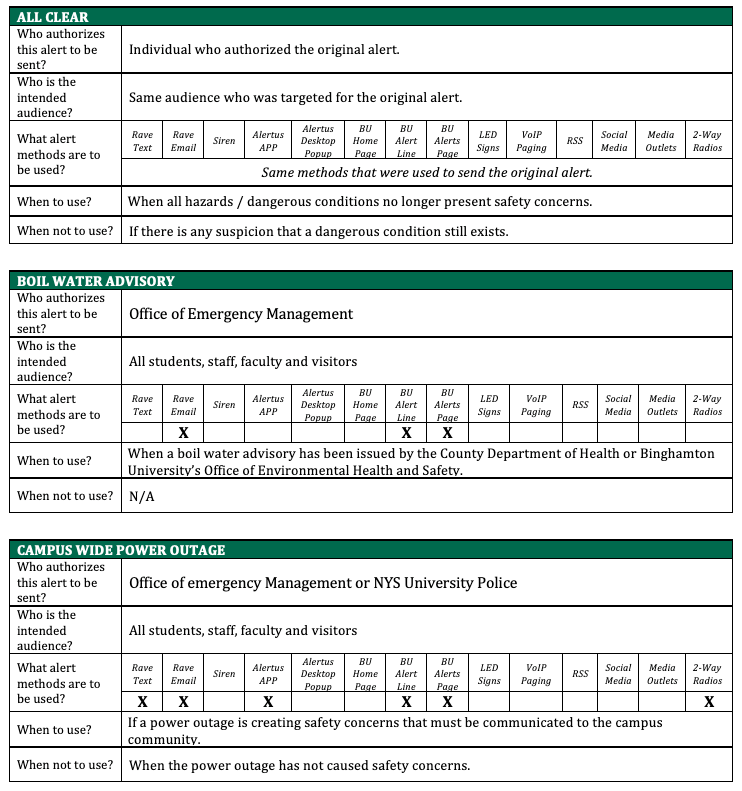
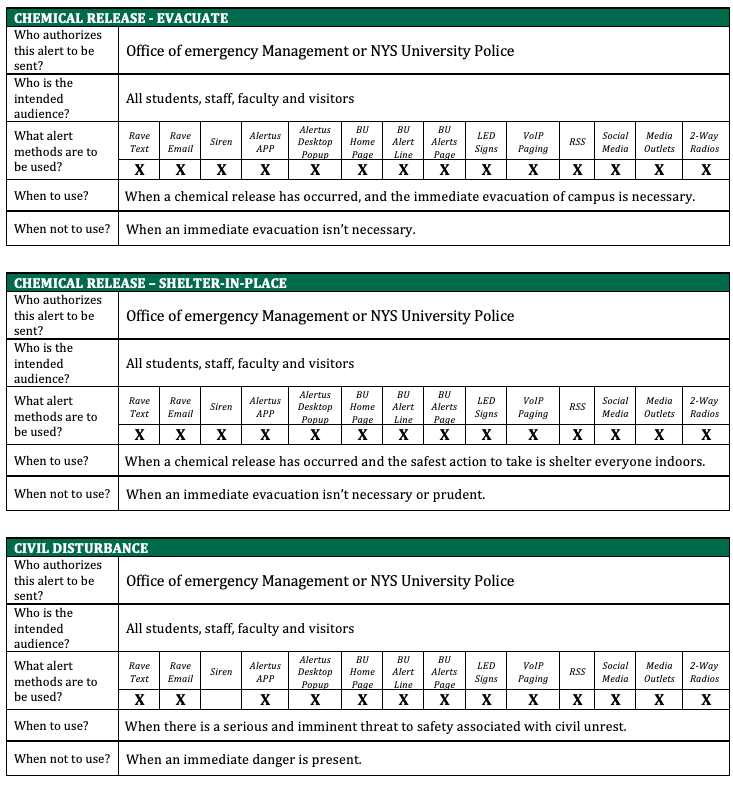
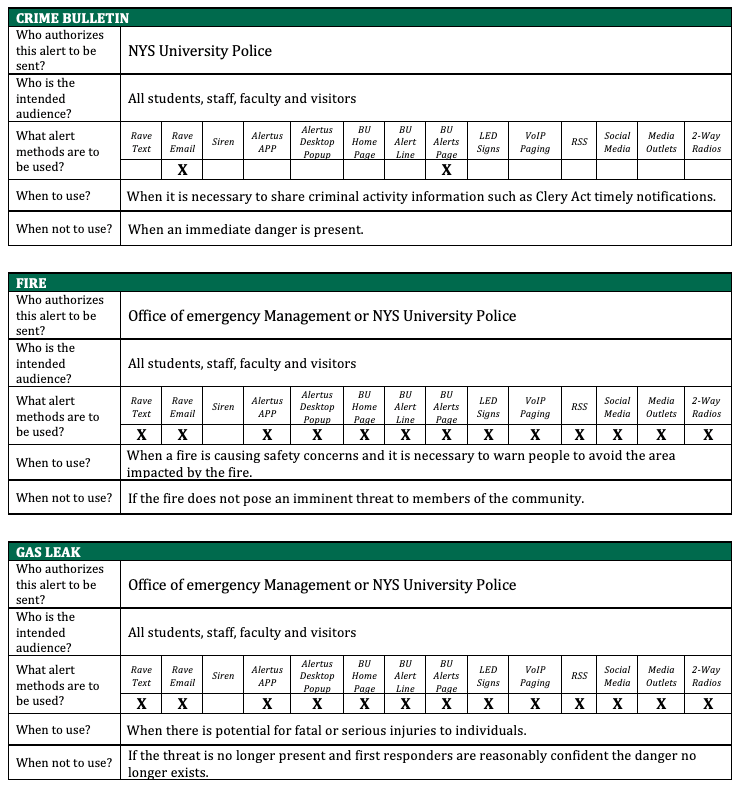
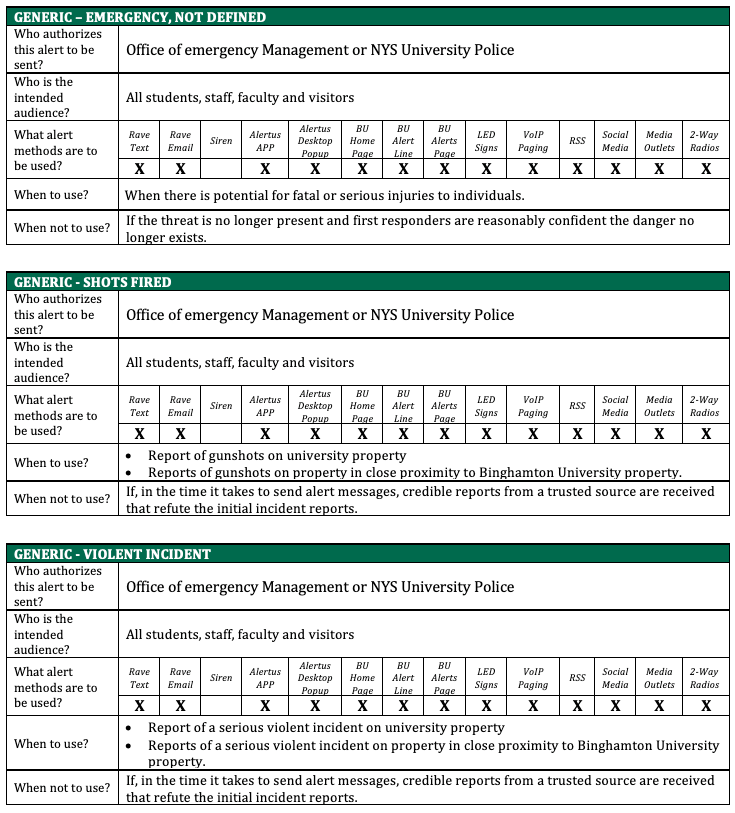
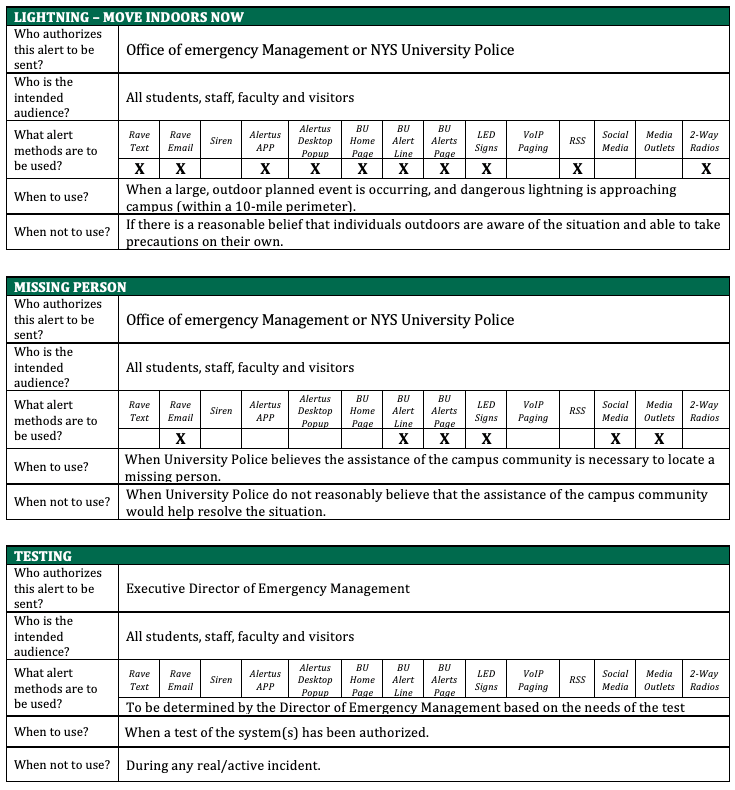
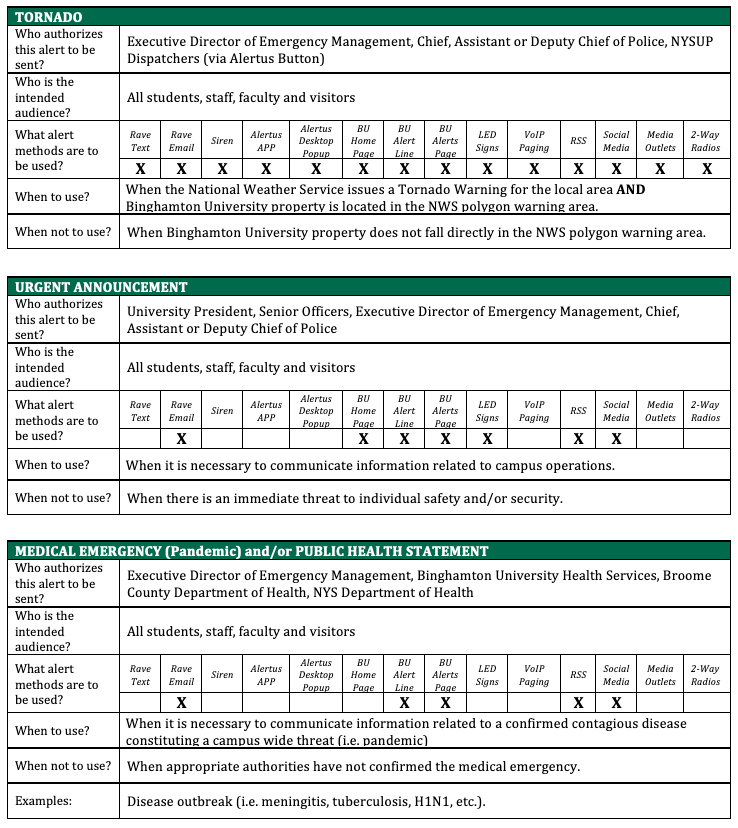
Appendix C - Notification System Elements
|
System |
Description |
Audience |
Limitations |
|
Campus website |
Communications and Marketing maintains the campus home web page. |
Students Faculty Staff Parents Public Media |
|
|
B-ALERT emergency messaging system |
B-ALERT is the official Binghamton University messaging system, providing notifications to students, staff and faculty via SMS text messaging, email, RSS feed and Social Media. The Office of Emergency Management manages the B-ALERT system. NYSUP and Communications and Marketing have access to the system. |
Students Faculty Staff |
|
|
Alertus |
Smartphone Notification Application Computer Desktop Notification Application |
Students Faculty Staff |
|
|
Outdoor siren |
The outdoor siren is capable of providing tone and voice signals. The system is pre-programmed with scripted messages that may be used during certain critical incidents. The siren is intended to alert people who are outside and was not designed to be heard by individuals who are already indoors. |
All people located outdoors, on the Vestal campus. |
|
|
BU Alert Line 607-777-7700 |
Calling this number will provide a recorded message with updated information regarding all emergency incidents and weather-related information for the Binghamton University campus. Communications and Marketing manages the recorded message on the BU Alert Line. |
Students Faculty Staff Parents |
|
|
Social media |
Communications and Marketing manages the University's official social media presence. These sites provide an opportunity to communicate quickly as well as when traditional methods may not be effective. |
Students Faculty Staff Parents Public Media |
|
|
Electronic Message Boards and TV Screens |
The University manages a series of electronic message boards and TV screens that are placed at various locations throughout the campus. Common locations for these types of signs include the entrances to campus as well as dining facilities. These boards may be quickly 'captured' and programmed to display emergency messages whenever necessary. |
Students Faculty Staff |
|
|
Campus VoIP telephone paging |
All University-owned hard-wired phones are capable of receiving a recorded voice message which is played over the phone's speaker. During an emergency incident, a recorded message containing critical information can be distributed to all campus phones. |
Faculty Staff |
|
|
University email Listservs B-Line Dateline |
The University manages several listservs that may be utilized during emergency incidents. B-Line is the official listserv for students and Dateline is the official listserv for staff and faculty. The listservs may be utilized to provide updates and critical information during emergency situations. |
Students Faculty Staff |
|
|
Local television and radio |
Binghamton University will continue to work with traditional media outlets to distribute information regarding emergency events and weather cancellations. |
Students Faculty Staff Parents Public Media |
|
|
Mobile public address systems (Vehicle mounted) |
Emergency vehicles on the Binghamton University campus are equipped with public address systems, which may be utilized to convey emergency messages when other methods may not be available or appropriate. |
All people located outdoors, on the Vestal campus. |
|
|
Courier/messenger |
Individuals may be used to distribute verbal or written messages. |
Students Staff Faculty |
|
|
Building fire alarm systems |
Each campus building is equipped with a fire alarm system capable of initiating a building evacuation. |
Automatically or manually in the presence of fire / smoke. Emergency Responders |
|
|
Campus emergency 1-800 telephone numbers |
The Telecommunications office of ITS maintains multiple 1-800 telephone numbers that may be activated during an emergency incident. These numbers are designed to handle increased traffic of incoming calls to the University. |
Students Faculty Staff Parents Public Media |
|